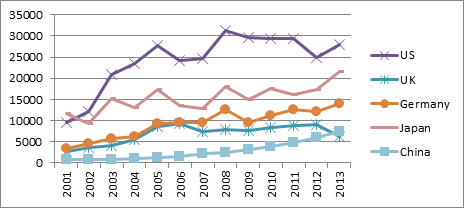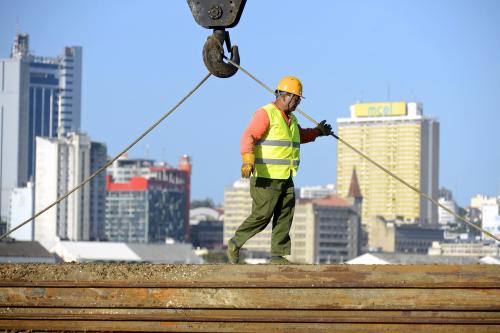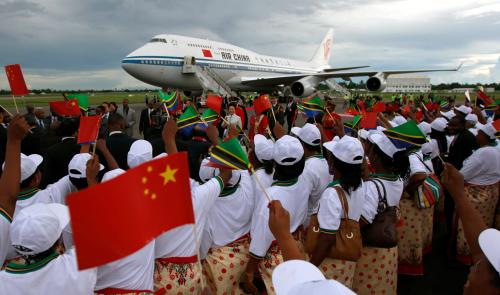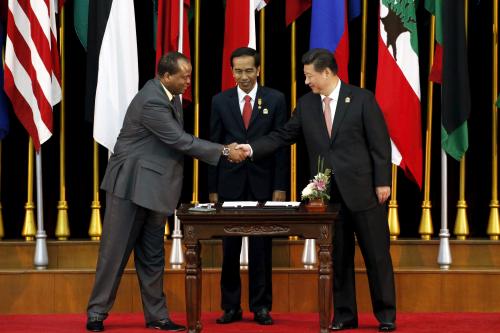China has provided foreign assistance since the 1950s, and is now the largest developing country to provide aid outside of the Development Assistance Committee (DAC), a forum of the world’s major donor countries under the Organization for Economic Cooperation and Development (OECD). Like its foreign policy more broadly, Chinese foreign assistance has adhered to the “Five Principles of Peaceful Coexistence” and emphasized the virtue of national self-reliance. At the same time, it has served a strategic purpose alongside other foreign policy priorities.
A slow start but a steady increase
Compared to top DAC donor countries, the scale of China’s foreign assistance is still relatively small. According to some estimates and OECD International Development Statistics, China’s gross foreign aid in 2001 was extremely limited, amounting to only about 1.8 percent of the total contribution by DAC donors. However, since launching its “Go Global” strategy in 2005, China has deepened its financial engagement with the world, and its foreign aid totals have grown at an average rate of 21.8 percent annually. In 2013, China contributed about 3.9 percent to total global development assistance, which is 6.6 percent of the total contribution by DAC countries and over 26 percent of total U.S. foreign aid.
Millions of USD (Current)
 Gross foreign aid provided by China versus major DAC donors
Gross foreign aid provided by China versus major DAC donors
And the lion’s share goes to: Africa
Africa is one of China’s most emphasized areas of strategic engagement. Particularly since the establishment of the Forum on China-Africa Cooperation (FOCAC) in 2000, the relationship between China and Africa has gotten closer and closer. In 2009, African countries received 47 percent of China’s total foreign assistance. Between 2000 and 2012, China funded 1,666 official assistance projects in 51 African countries (the four countries that don’t have diplomatic relations with China—Gambia, Swaziland, Burkina Faso, and São Tomé and Príncipe—were left out), which accounted for 69 percent of all Chinese public and private projects. Among the 1,666 official projects, 1,110 qualified as Official Development Assistance (ODA)—defined by the OECD as flows of concessional, official financing administered to promote the economic development and welfare of developing countries. The remaining 556 projects could be categorized, also according to the OECD, as Other Official Flow (OOF)—transactions by the state sector that are not “development-motivated” or concessional (such as export credits, official sector equity and portfolio investment, and debt reorganization). (Note: in terms of dollar amounts, not included in the statistics here, most Chinese lending to Africa and other parts of the developing world is not concessional and is therefore not foreign aid.)
Zeroing in on infrastructure
About 61 percent of Chinese concessional loans to Africa are used for infrastructure construction, and 16 percent are for industrial development. The three areas that receive the largest allocations of Chinese concessional loans are transport and storage; energy generation and supply; and industry, mining, and construction. A small portion of the remaining allocations go to health, general budget support, and education.
Some have interpreted these trends to mean that China is making an effort to export domestic excess capacity in manufacturing and infrastructure, especially considering the uncertainties of China’s economic transition. But the motivations are broader than that. China’s “Africa Policy”—issued in December 2015, in Johannesburg—clearly expresses the Chinese government’s belief that infrastructure construction is a crucial channel for African development. This notion could be connected to the domestic Chinese experience of having benefited from the technological diffusion of foreign aid and foreign direct investment in the construction sector. Moreover, in practice, China’s more than 20 years of experience in implementing international contract projects, as well as advanced engineering technologies and relatively low labor costs, have proved to be a comparative advantage in Chinese foreign assistance. In addition, by prioritizing the principles of non-interference and mutual benefit, China is more comfortable providing infrastructure packages (e.g., turn-key projects) than many other countries.
Doing assistance better
Legitimate concerns have been raised about China’s tendency to facilitate authoritarianism and corruption, as well that its assistance does not always trickle down to the poor. As such, the state-to-state Chinese approach to providing assistance should be reformed. Globalization scholar Faranak Miraftab indicates that on-the-ground partnerships between communities and the private sector—mediated by the public sector—could achieve synergies to overcome certain shortcomings, creating a win-win situation. With deeper involvement by domestic assistance providers, Chinese foreign assistance could touch more people’s lives by tackling both the short- and long-term needs of the most under-resourced parts of civil society. Domestic assistance providers should exploring public-private partnerships, which among other benefits could yield increased foreign assistance services. By focusing on its comparative advantage in contributing to infrastructure projects that benefit the general public while also facilitating participation from civil society, Chinese foreign assistance could bring more concrete benefits to more individuals.
China has already begun tackling these and other weaknesses. Although infrastructure and industry still account for the largest share of total official projects in Africa, China has intentionally strengthened its official development finance efforts in areas related to civil society. Projects have surged in the areas of social infrastructure and services, developmental food aid and food security, support to non-governmental organizations, and women in development, to name a few. Moreover, following President Xi Jinping’s promise at the United Nations summit in September 2015, an initial $2 billion has been committed as a down payment toward the China South-South Cooperation and Assistance Fund. The funding is primarily designed to improve the livelihoods of residents of recipient countries and diversify domestic aid providers (e.g., NGOs) qualified to participate or initiate assistance projects in the least-developed countries.
In order to achieve positive results, it is critical for the Chinese government to carry out detailed management initiatives to engage civil society: for example, establishing a complete system for information reporting and disclosure (actions have already been taken in several ministries and bureaus), publishing guidelines for the private sector to develop assistance services overseas, and improving coordination and accountability among ministries and within the Ministry of Commerce. Although challenges still remain, Chinese foreign assistance is moving in a positive direction without abandoning its defining characteristics.






Commentary
Chinese foreign assistance, explained
July 19, 2016